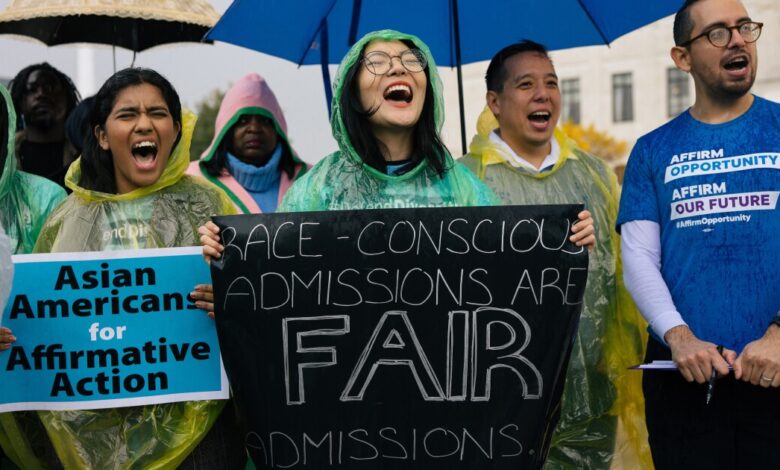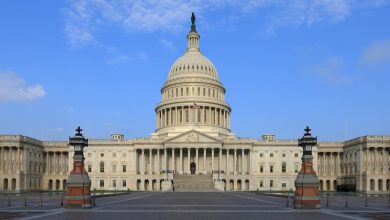U.S. Supreme Court Strikes Down Race-Conscious Admissions Nationwide

[ad_1]
The United States Supreme Court on Thursday struck down colleges’ use of race-conscious admissions nationwide, ruling in a pair of closely watched cases that the practice is racially discriminatory.
Writing for the court’s majority, Chief Justice John Roberts wrote that policies that claim to consider an applicant’s race as one factor among many are in fact violating the equal protection clause of the 14th Amendment of the U.S. Constitution.
“The court has permitted race-based college admissions only within the confines of narrow restrictions: such admissions programs must comply with strict scrutiny, may never use race as a stereotype or negative, and must — at some point — end,” Roberts wrote. “Respondents’ admissions systems fail each of these criteria.”
The cases, Students for Fair Admissions v. President and Fellows of Harvard and Students for Fair Admissions v. University of North Carolina, challenged those institutions’ use of that contentious practice, known as race-conscious admissions — saying they resulted in discrimination against Asian American applicants. UNC and Harvard defended their policies, and prevailed in court until the Supreme Court in January 2022 agreed to consider the cases. The justices heard oral arguments in both cases on October 31, 2022.
The decision reverses decades of legal precedent affirming that a diverse student body is a “compelling state interest,” a stance that had allowed colleges to use race-conscious admissions to reach that goal. In 1978, Regents of the University of California v. Bakke established that colleges could consider race in their admissions decisions to achieve “educational benefits,” not to remedy past discrimination. In 2003, Grutter v. Bollinger, in which a white applicant sued the University of Michigan Law School over her admissions denial, upheld the Bakke ruling.
The compelling interests identified by the colleges — training future leaders, acquiring new knowledge based on diverse outlooks, promoting a robust marketplace of ideas, and preparing engaged and productive citizens — “cannot be subjected to meaningful judicial review,” Roberts wrote.
“While these are commendable goals, they are not sufficiently coherent for purposes of strict scrutiny,” he wrote. “It is unclear how courts are supposed to measure any of these goals, or if they could, to know when they have been reached so that racial preferences can end.”
The UNC case was a 6-3 ruling; the Harvard case was a 6-2 ruling, due to the recusal of Justice Ketanji Brown Jackson.
In the oral arguments last fall, the court’s conservative majority sounded skeptical of the colleges’ defenses, focusing much of their questioning on how college admissions might change if the court acted to bar admissions officers from considering race in their evaluations.
That will now be a question for selective colleges to take up. They will very likely draw lessons from colleges in states that have already banned race-conscious admissions, like California and Michigan.
In dissents, Justice Sonia Sotomayor, in the Harvard case, and Justice Jackson, in the UNC case, wrote that the ruling would have devastating effects on equity in higher education. “Today, this court stands in the way and rolls back decades of precedent and momentous progress,” Sotomayor wrote.
The court’s decision, Sotomayor continued, “cements a superficial rule of colorblindness as a constitutional principle in an endemically segregated society where race has always mattered and continues to matter.”
Jackson wrote in her dissent that the decision effectively amounted to ignorance. “With let-them-eat-cake obliviousness, today, the majority pulls the ripcord and announces ‘colorblindness for all’ by legal fiat,” Jackson wrote. “But deeming race irrelevant in law does not make it so in life.”
After California’s Proposition 209 eliminated race-based affirmative action in the state’s public colleges in 1998, enrollment of students of color plummeted, especially at the system’s most selective institutions. The University of California system has spent more than a half-billion dollars on recruitment programs to stop the decline, but student diversity has continued to lag.
The University of Michigan at Ann Arbor told the justices last year that officials had tried a host of strategies to enroll more students of color in a race-neutral way — such as offering more financial aid for students from lower socioeconomic backgrounds — with little success.
[ad_2]
Source link






